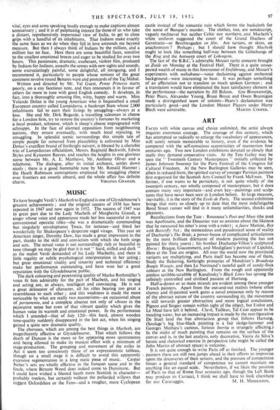ART
FACED with white canvas and choice unlimited, the artist always requires enormous courage. The courage of this century, which has attempted so radically to enlarge the vocabulary of appearances, will surely remain memorable to history, even if the evidence be compared with the self-conscious eccentricities of mannerism four centuries ago. Two new London exhibitions dovetail so closely that really they demand consecutive visits. At the Tate Galley may be seen the "Twentieth Century Masterpieces" initially collected by James Johnson Sweeney for the Paris Festival of the Congress for Cultural Freedom. At the New Burlington Galleries may be seen, albeit in reduced form, the spirited survey of younger Parisian painters first organised for the Scottish Arts Council by Frank McEwen. The former, if one wants to be pernickety, is not quite wholly of the twentieth century, nor wholly composed of masterpieces, but it does contain many very important—and even key—paintings and sculp- tures that have never been seen in London before. In large measure, inevitably, it is the story of the Ecole de Paris. The second exhibition brings that story so closely up to date that the most indefatigable Bond Street runner will find in it many unfamiliarities, shocks and pleasures. Recollections from the Tate : Rousseau's Poet and Muse (the poet was Apollinaire, and the Douanier was so anxious about the likeness that he measured his sitter's nose with a ruler) ; a fauve Matisse, Boy with Butterfly Net ; the tremendous and paradoxical sense of reality of Duchamp's The Bride, a power-house of complicated articulations by the most brilliant dilettante of modern painting (he has not painted for thirty years) ; his brother Duchamp-Villon's sculptured Horse; Braque, Giacommetti, and Modigliani's portrait of Lipchitz. Here at the Tate are origins. All over the world now the provincial variants are multiplying, and Paris itself has become one of them. Study the flickering, forthright primaries of Mondrian 's Broadway Boogie Woogie, and then Le Normand's tasteful quilt of candy-floss colours at the New Burlington. From the rough and apparently aimless scribble-scrabble of Kandinsky's Black Lines has sprung the infinitely controlled and civilised passion of Hartung.
Half-a-dozen or so main strands are evident among these younger French painters. Apart from the out-and-out realists (whose often clumsy and ill-painted work gains a novel eminence only by reason of the abstract nature of the country surrounding it), the movement is still towards greater abstraction and more logical conclusions. Pignon and Singier remain within sight of the object, but Esteve and Le Moal have left it behind. Clay& Tailleux, Tal Coat appear to be treading water, but an increasing impact is made by the non-figurative De Stael land the free abstraction group that follows Hartung. (Soulage's big blue-black painting is a fair sledge-hammer and Georges Mathieu 's curious, furious Inertia is strangely affecting.) In the midst of much painting that remains on the surface of the canvas and is, in the last analysis, only decorative, Vieira da Silva's heroic and rhetorical exercise in perspective (she might be called the John Martin of abstract space) is welcome.
It is not quite enough to write Paris off as finished. The younger painters there are still two jumps ahead in their efforts to improvise upon the discoveries of their seniors, and the pressure of competition forces a general standard of competence we cannot maintain on anything like an equal scale. Nevertheless, if we liken the position of Paris to that of Rome four centuries ago, though the Left Bank may produce its Carracci, I think we shall have to look elsewhere


































 Previous page
Previous page